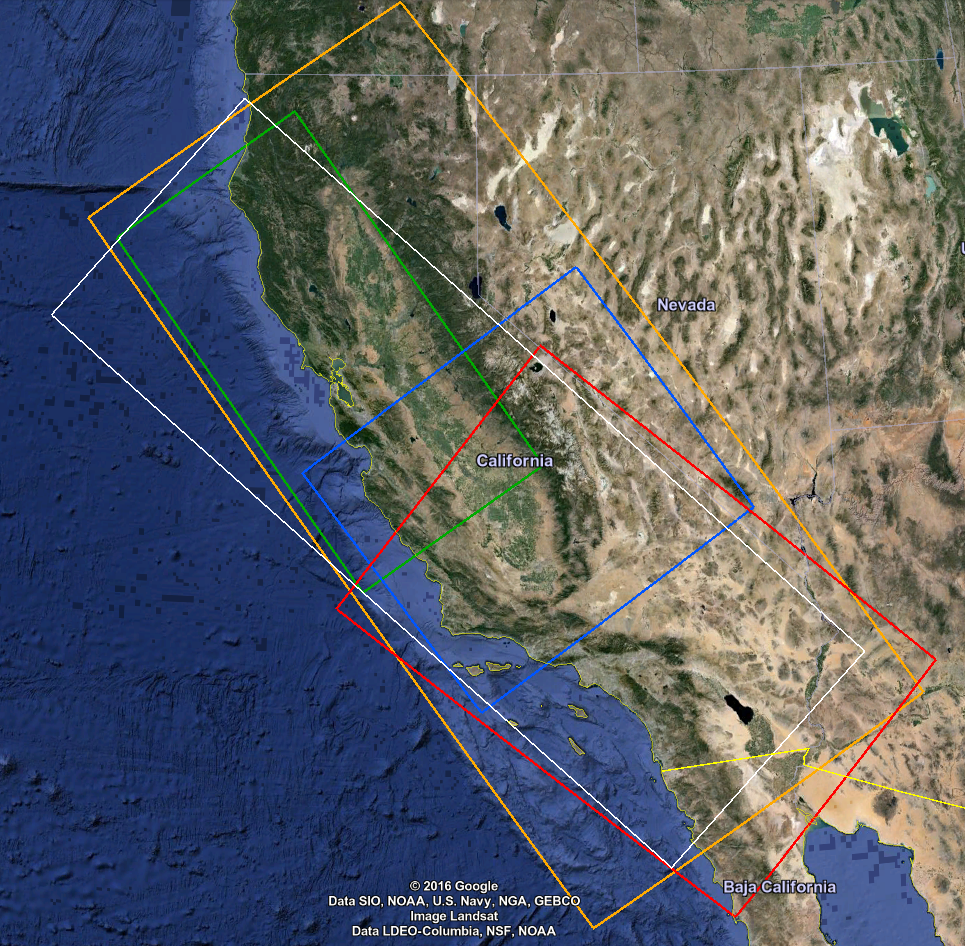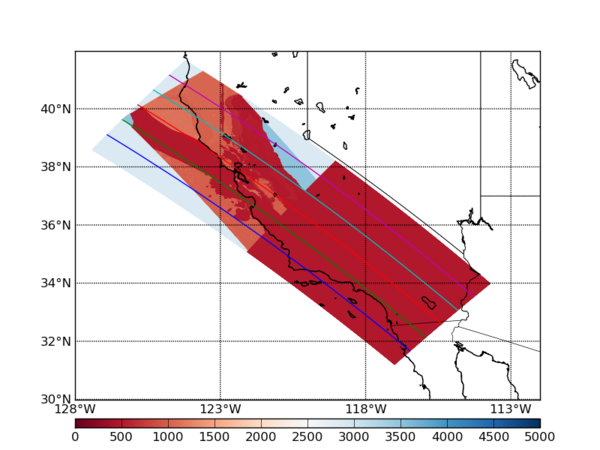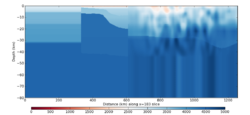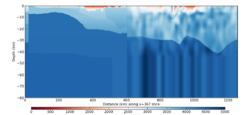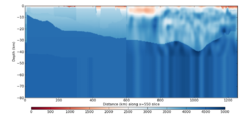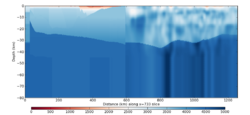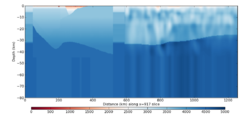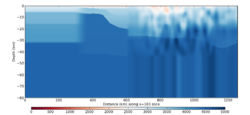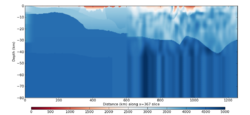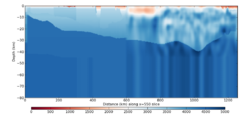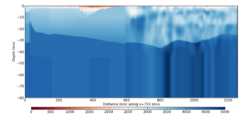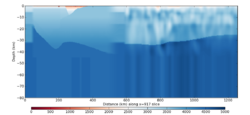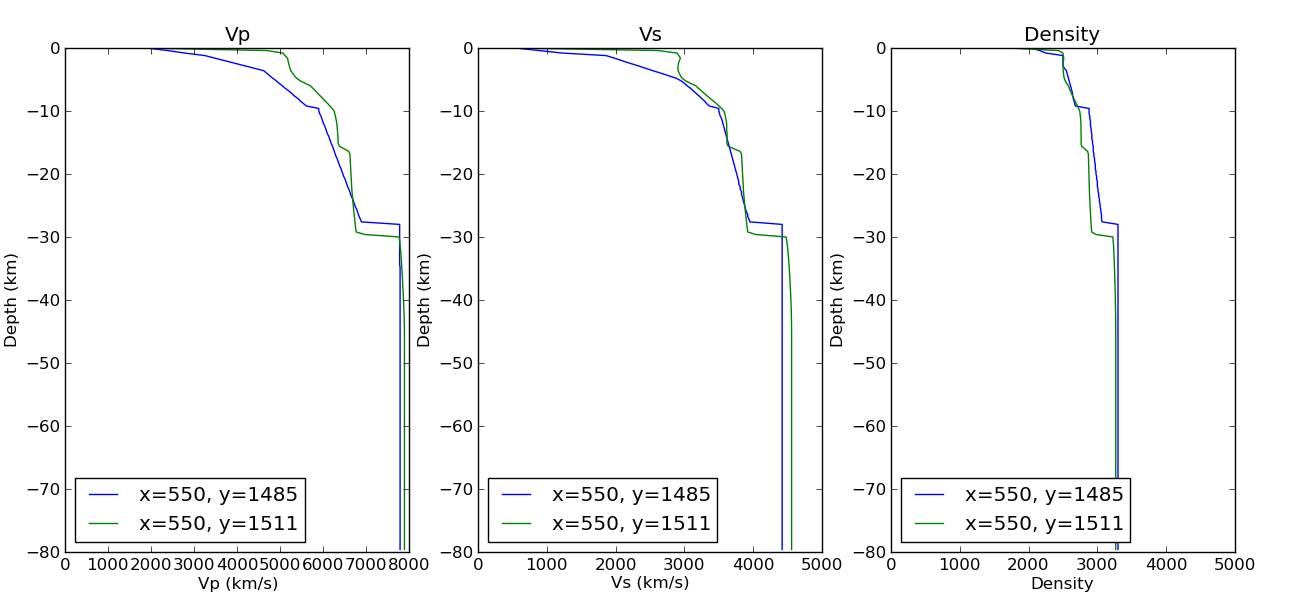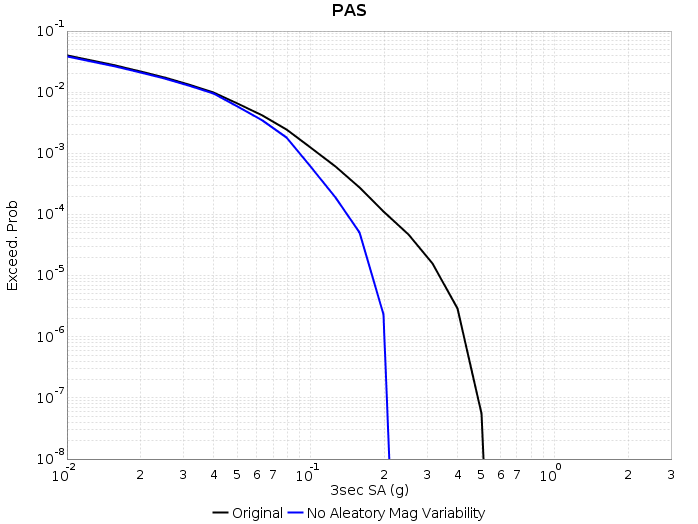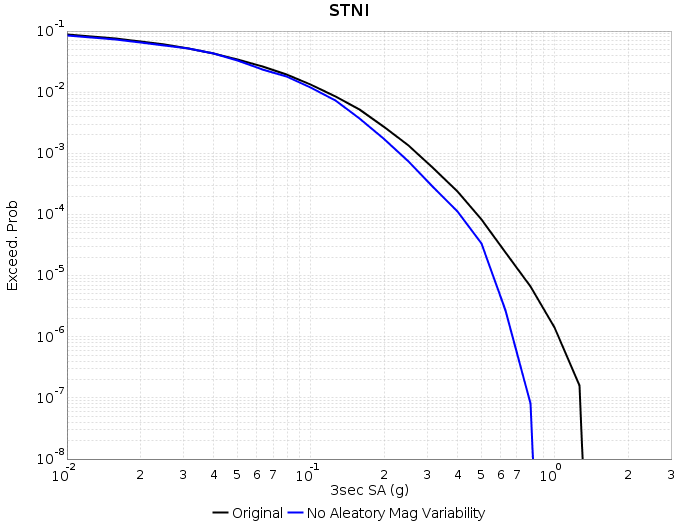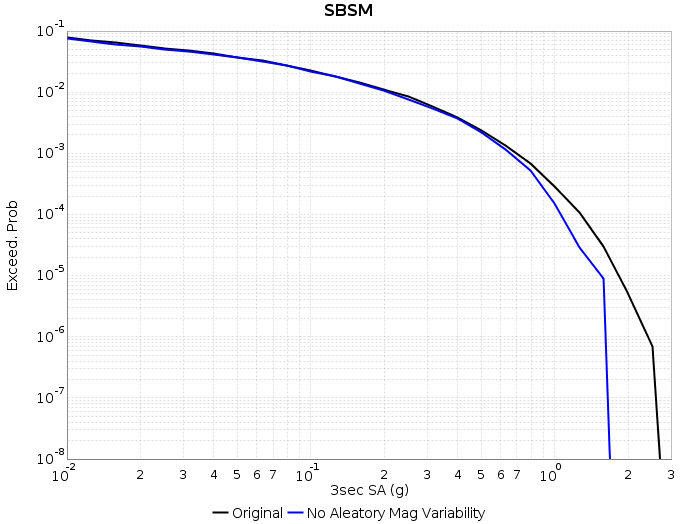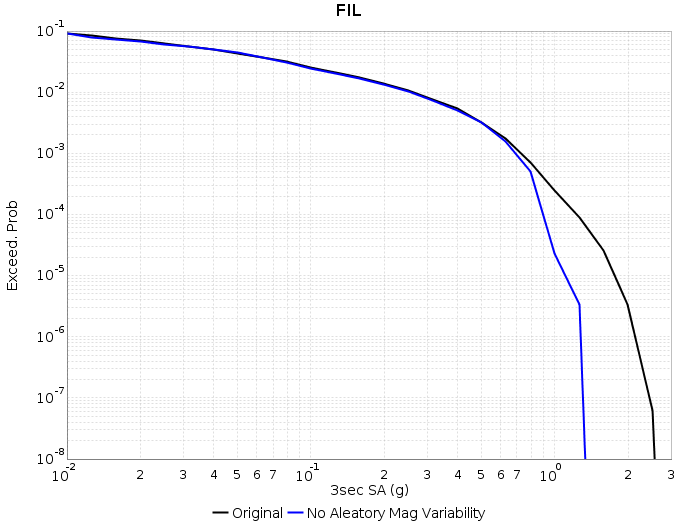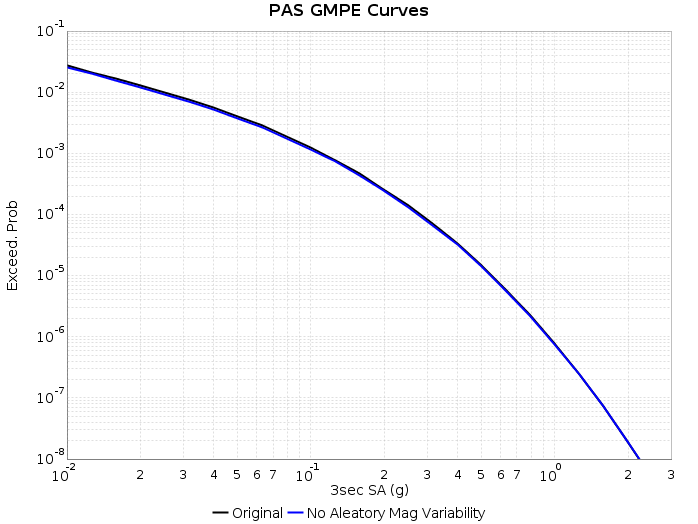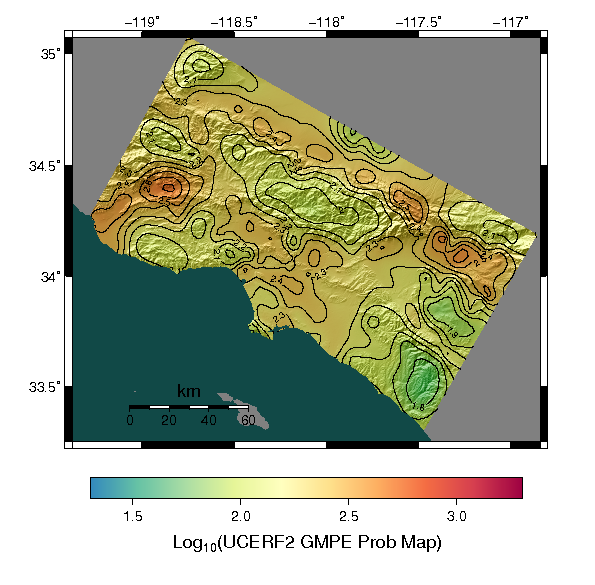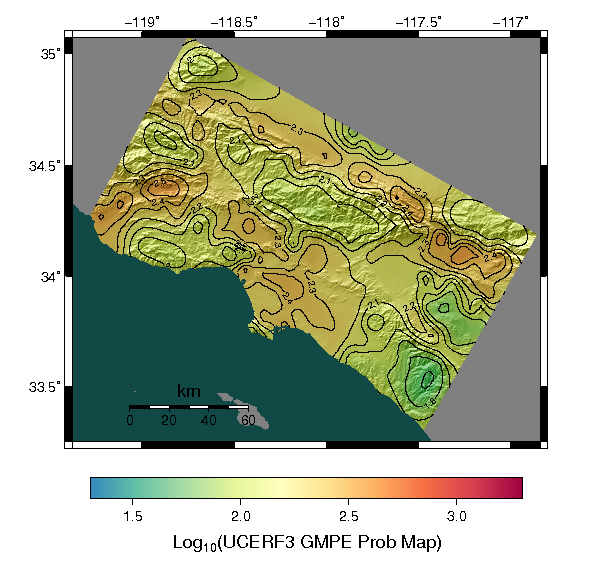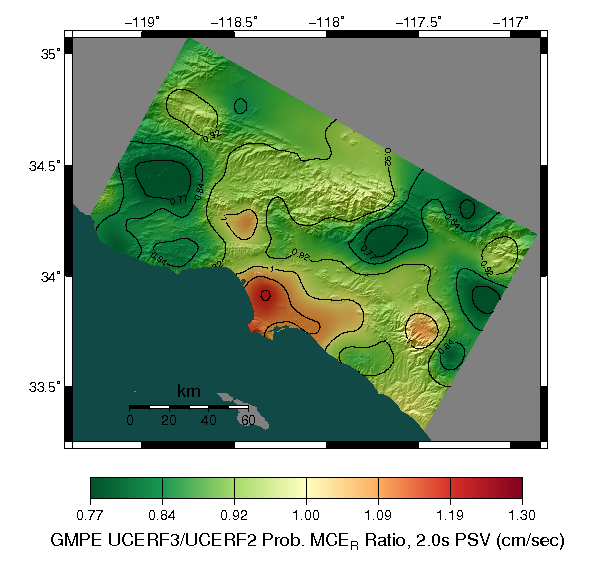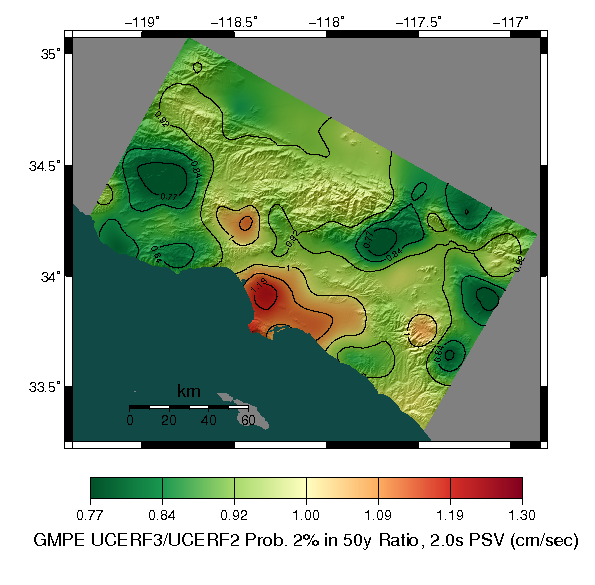CyberShake UCERF3 Migration
This page will be used to document progress migrating CyberShake to UCERF3
Contents
GMPE Downsampling Test
This tests creates a downsampled UCERF3 forecast for southern california. Every rupture that is outside of Southern California (using the white dashed dividing line seen in the figure on the front of the UCERF3 Fact Sheet) is removed. If a rupture is partially outside, it is removed and its rate is added to the largest subset rupture which is entirely inside the region. This results in 64992/253706 ruptures retained for UCERF3 Fault Model 3.1.
MFD Comparison
The following figure shows the resulting MFD following this downsampling proceedure (blue curve). The original MFD (black curve) and MFD were we to just exclude partial ruptures rather than add their rate to subset ruptures (green curve) are also shown. Note that these are nucleation MFDs (as opposed to participation) and only include supra-seismogenic fault ruptures.
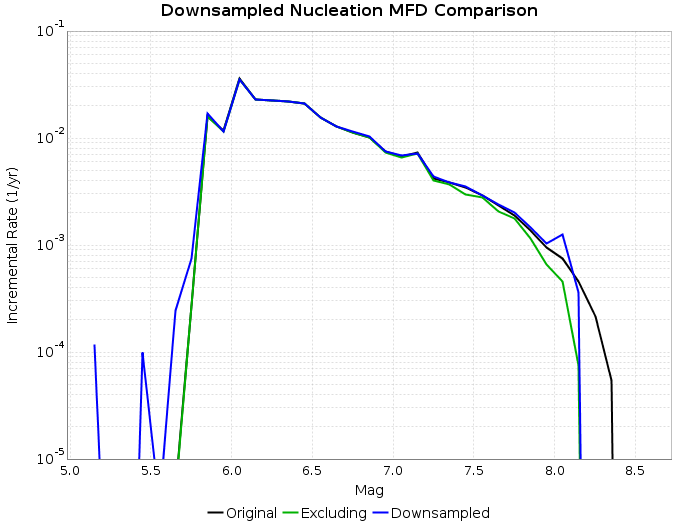
The following figure shows a participation MFD for the Mojave (S) section of the San Andreas to better illustrate the consequences of applying this algorithm (same colors).
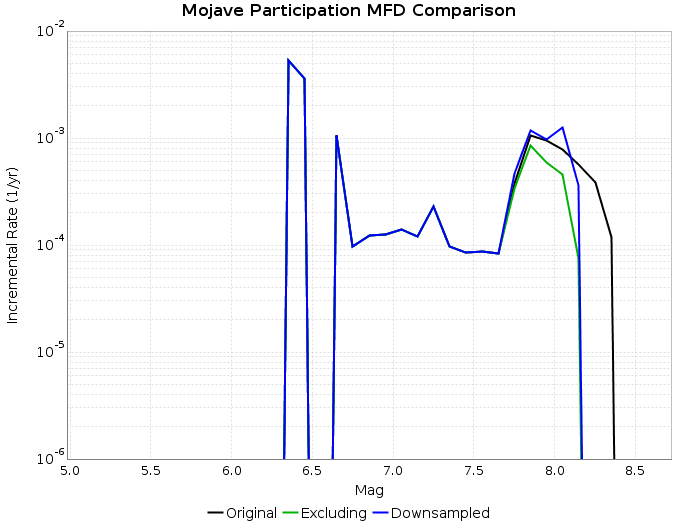
Hazard Curve Comparison
The following figures show the hazard curve calculations using the average NGA-West2 GMPE following this downsampling proceedure (blue curves). The original curve (black curves) and curve were we to just exclude partial ruptures rather than add their rate to subset ruptures (green curves) are also shown. These calculations are for 3 second SA and include site effects (Wills 2006 Vs30 and Z1.0/2.5 from CVM-S4.26).
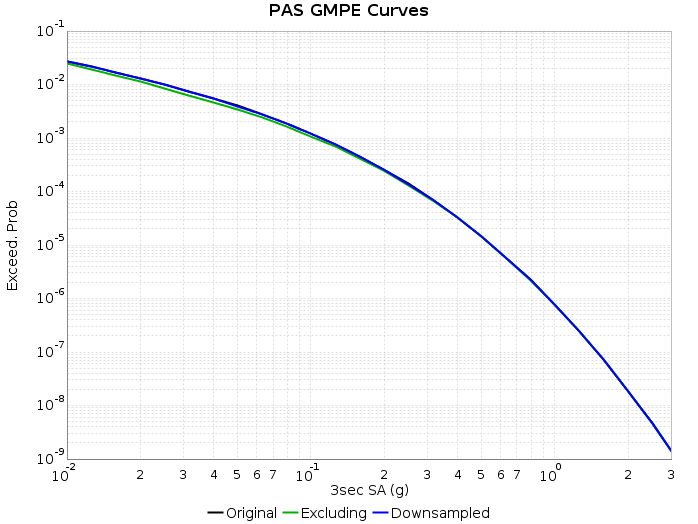
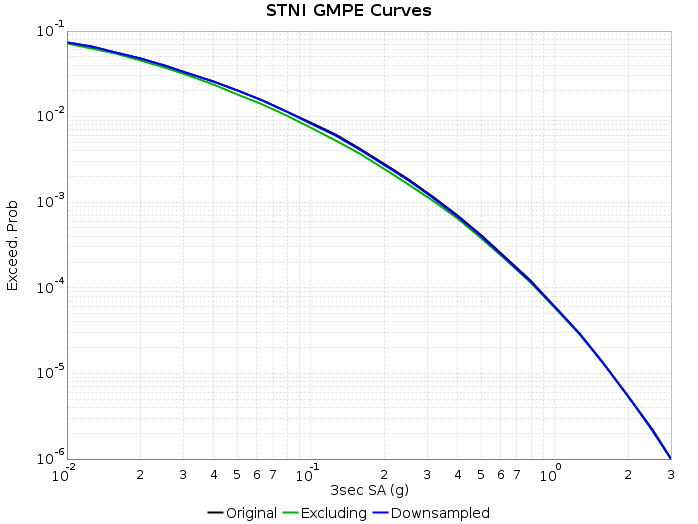
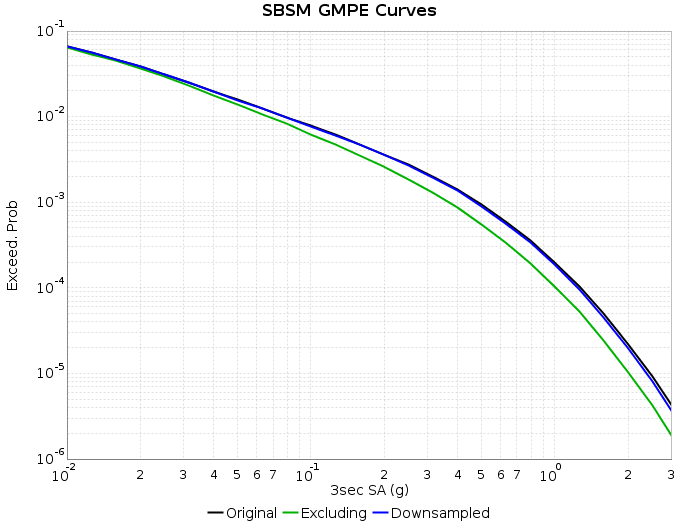
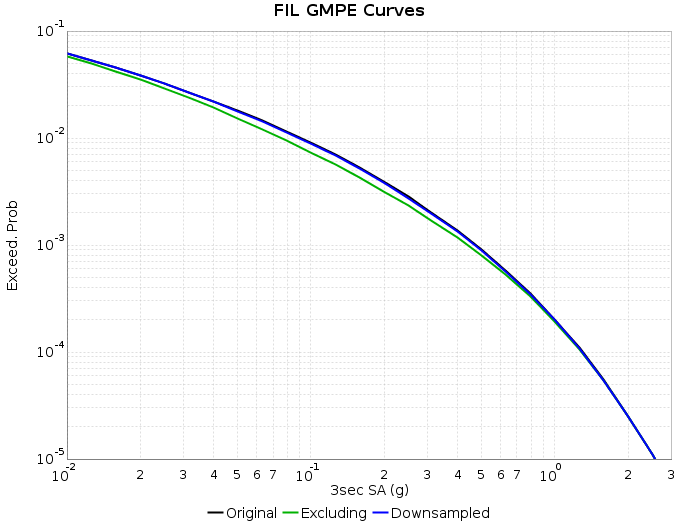
Physics-based Downsample Test
We plan to perform a downsampling test by calculating SGTs for the entire SAF, generating seismograms at USC from central and northern CA SAF events, and comparing the seismograms and intensity measures to see if downsampling is valid.
Volume
Below is an image of the proposed simulation region, in white (440 km x 1256 km x 80 km, 44.2B points). Potential velocity models (CVM-S5 in red, CCA in blue, USGS Bay Area in green, Lin-Thurber in orange) are also shown. A KML file of the velocity model regions is available here.
We propose using the CVM-S5 model in Southern California and the USGS Bay Area model in Northern CA. Since some of the box extends beyond Lin-Thurber, we propose using the SCEC 1D model in regions not covered by CVM-S5 or USGS Bay Area to reduce the amount of smoothing necessary.
Velocity Model
We have produced a velocity mesh and applied smoothing on all the interfaces. For smoothing, we have used a simple average of surrounding points. Smoothing was performed up to 5 km from a model interface, and only in the X-Y plane. For testing purposes, we have started with a mesh with 400 m spacing, and a minimum Vs=500 m/s. Additionally, we extend the values at 45 km down to the 80 km depth.
Plots before and after smoothing are below.
Horizontal plots
| Original unsmoothed model | Model with smoothing | |
|---|---|---|
| Entire volume, horizontal slice at depth=0 km | 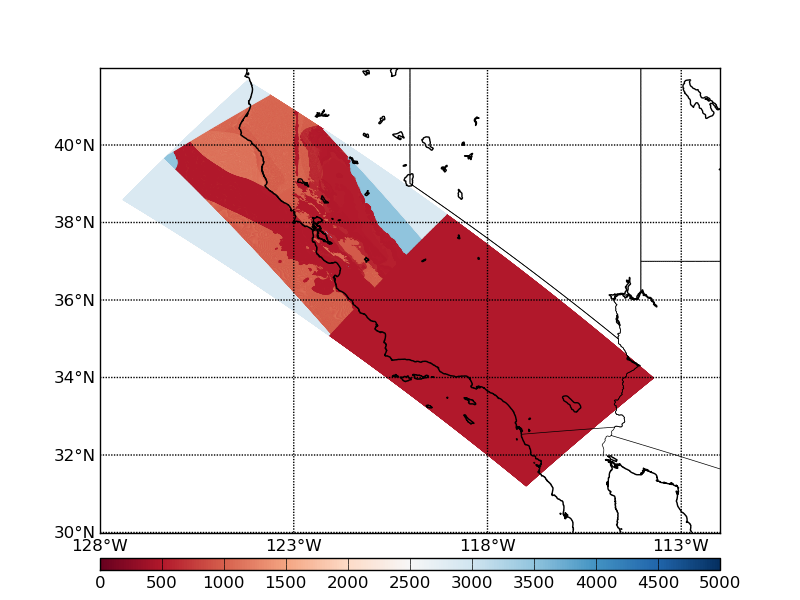
|
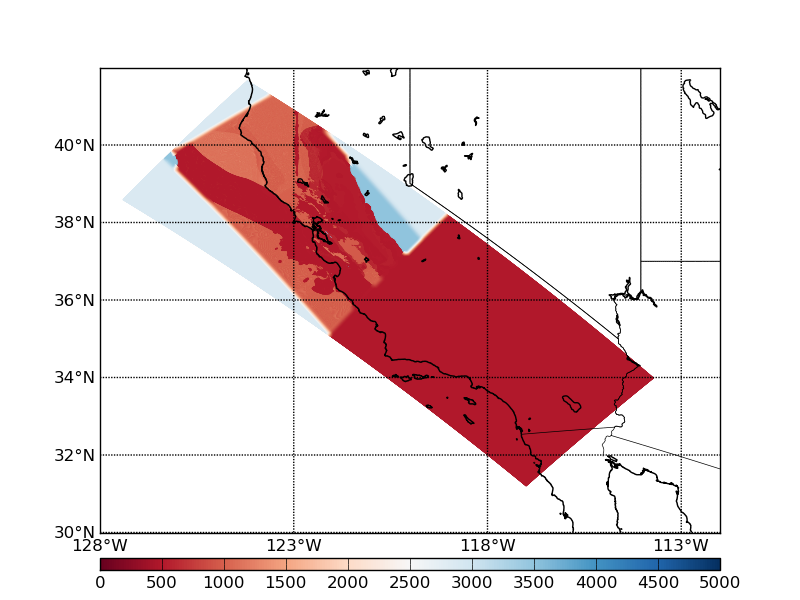
|
Vertical plots
To show cross-section locations:
| X=183 (blue line) | X=367 (green line) | X=550 (red line) | X=733 (cyan line) | X=917 (magenta line) | |
|---|---|---|---|---|---|
| Original unsmoothed model | |||||
| Smoothed model |
Profiles
Below are profiles at (36.6861, -120.6374), x=550 y=1485, and (36.6237, -120.5506), x=550 y=1511, on the NW and SE sides, respectively, of the USGS Bay Area / CVM-S4.26 interface.
Unsmoothed:
Forward Simulation
To verify that we are comfortable with the smoothing performed here, we decided to run a forward simulation to look for reflections off the interfaces.
Source
We generated SRFs from a modified UCERF3 (constant depth) full San Andreas rupture. We selected 3 events, with southern, central, and northern hypocenters.
- 200m: Southern (33.65030, -116.07630, 3.09640 km deep): SRF shear modulus Rupture Plot
- 200m: Central (36.07290, -120.63230, 10.69480 km deep): SRF shear modulus
- 200m: Northern (40.09420, -124.16150, 7.89540 km deep): SRF shear modulus
- 1 km: Southern (33.65080, -116.07560, 7.09560 km deep): SRF shear modulus
Simulation Parameters
- 43000 timesteps, dt=0.02, 860 seconds elapsed time
- 400 m grid spacing
- Same volume as identified in the white box above (3140x1100x200)
- Boundary width of 50 grid points
- Output saved on the surface with a decimation of 10 in X and Y
- Decimation of 20 in T.
Aleatory Magnitude Variability Test
UCERF2 applied aleatory magnitude variability to all non-floating rupture sources. This was applied as a truncated Gaussian with sigma=0.12, truncated on either side at 2 sigma.
For example, the SAF S. Mojave characteristic source has 7 ruptures with identical full segment rupture surfaces but varying magnitudes and probabilities. Here are the ruptures and their associated probabilities:
| Source ID | Rupture ID | Magnitude | Probability |
|---|---|---|---|
| 90 | 0 | 6.95 | 7.77415e-06 |
| 90 | 1 | 7.05 | 4.2332184e-05 |
| 90 | 2 | 7.15 | 0.000109296016 |
| 90 | 3 | 7.25 | 0.00015457721 |
| 90 | 4 | 7.35 | 0.00012129413 |
| 90 | 5 | 7.45 | 5.2423315e-05 |
| 90 | 6 | 7.55 | 1.0574104e-05 |
UCERF2/CyberShake Hazard Curve Comparison
I calculated a select few CyberShake hazard curves to show the influence of this variability on results (hazard dataset 35 - CVM-S4.26, 3 second SA). The black curves are normal CyberShake curves, and the blue curves have the aleatory variability removed via the following algorithm:
For each UCERF2 rupture where aleatory variability was applied (103 sources which were used in these calculations), I find the mode of the distribution (the magnitude 7.25 rupture for the above SAF S. Mojave example), and modify rupture probabilities by assigning the total source probability to that rupture and removing the other ruptures from the calculation. This is not exactly equal to the mean magnitude for the source as the Gaussian distribution is regularized into delta=0.1 magnitude bins, but it should be close enough for demonstration purposes. Here is how that example source would look after applying this algorithm:
| Source ID | Rupture ID | Magnitude | Probability |
|---|---|---|---|
| 90 | 0 | 6.95 | 0 |
| 90 | 1 | 7.05 | 0 |
| 90 | 2 | 7.15 | 0 |
| 90 | 3 | 7.25 | 0.00049817459 |
| 90 | 4 | 7.35 | 0 |
| 90 | 5 | 7.45 | 0 |
| 90 | 6 | 7.55 | 0 |
UCERF3/GMPE Hazard Curve Comparison
We can also do the same test with UCERF3 and the NGA-West2 GMPEs. As expected, aleatory variability is relatively insignificant for GMPEs at least with UCERF3.
UCERF3 vs UCERF2 GMPE Comparison Maps
These maps compare probabilistic UCERF3 and UCERF2 MCEr results (risk targeted ground motions) for the NGA-West2 GMPEs in the CyberShake region. Trends are similar to those seen in the uniform hazard maps posted as UCERF3 electronic supplements for 1sec 2% in 50 Years and 1sec 10% in 50 years. Maps shown below are for 2 second SA.
This is the same ratio but of 2% in 50 year values:
Disaggregation
I have calculated disaggregated hazard curves for 3 CyberShake sites where the UCERF3/UCERF2 differences are greatest. In all hazard curve and fault magnitude frequency distribution plots linked below, the red curves are for UCERF2 and the blue curves are for UCERF3. All results are for 1 year Poisson models
s365: LA Basin (UCERF3 is higher)
Hazard Curves UCERF2 Disaggregation UCERF3 Disaggregation
This is the center of the red spot in the LA basin. The largest change seems related to the increase in rate on the Newport-Inglewood Fault (MFD plot).
s541: Claremont Area (UCERF3 is lower)
Hazard Curves UCERF2 Disaggregation UCERF3 Disaggregation
This is the CyberShake site where the UCERF3/UCERF2 ratio is lowest, in the Claremont area on the southeast side of the San Gabriel Mountains. Hazard at this site in UCERF2 is dominated by the Cucamonga Fault (MFD plot) which is treated very differently in UCERF3. It is allowed to link up with other faults in UCERF3 resulting in a large decrease in the overall rate of events, instead participating in larger more infrequent events.
FIL: Filmore/Ventura Basin (UCERF3 is lower)
Hazard Curves UCERF2 Disaggregation UCERF3 Disaggregation
This another CyberShake site where the UCERF3/UCERF2 ratio is low, deepest portion of the Ventura Basin. Hazard at this site in UCERF2 is dominated by the San Cayetano (MFD plot) which is treated very differently in UCERF3. It is allowed to link up with other faults in UCERF3 resulting in a large decrease in the overall rate of events, instead participating in larger more infrequent events.
